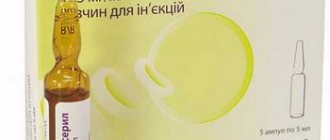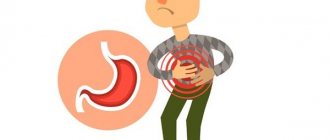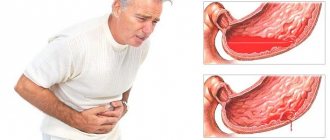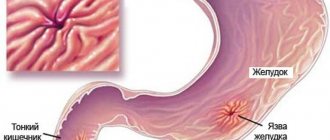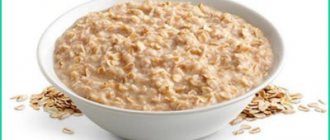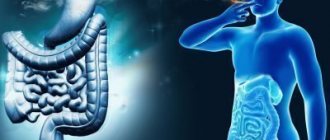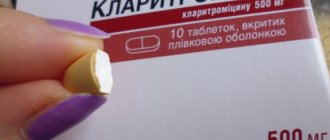Drug therapy for gastric and duodenal ulcers includes the use of several groups of drugs. Some are prescribed in tablet form, others - in the form of injections or drips. The purpose of prescribing these groups of drugs will be to return the disease to a stage of stable remission.
If you treat a disease that affects the gastric and intestinal tract using exclusively traditional or alternative medicine, this will not bring the desired effect and can worsen the patient’s condition. It is known that folk remedies are significantly inferior to medications in terms of effectiveness. Hydrogen peroxide is often used in alternative medicine to treat stomach ulcers.
For drug treatment, not one specific medicine for stomach ulcers is used (for example, Festal), but a number of pharmacological groups. Some are designed to influence the cause of the disease, others - on individual pathogenetic links.
A competent combination of drugs will give a sustainable improvement; the doctor must select the options.
The attending physician will perform a full examination and recommend which pills to take for stomach ulcers.
List of effective antibiotics
Treatment of gastric and duodenal ulcers is based on complex therapy including antibiotics. This category of drugs is used to eliminate the bacteria Helicobacter pylori. The most popular medications are discussed below.
Azicine
An effective antibiotic of semi-synthetic origin from the group of macrolides with a pronounced antibacterial effect. The active substance azithromycin inhibits protein synthesis and inhibits the activity of pathogenic microorganisms.
The drug is prescribed for gastric and duodenal ulcers to eliminate progressive Helicobacter pylori. The medicine is also effective for various other infections of the respiratory system, genitourinary system, and gynecological diseases that are sexually transmitted.
To treat an ulcer, the antibiotic dosage is 1000 mg once a day for 3 days. The duration of therapy is determined by the attending physician. Contraindications: liver and kidney dysfunction, pregnancy, breastfeeding, intolerance to components, children under 3 years of age. Price 150–200 rubles.
Clarithromycin
One of the effective antibiotics of the macrolide group with a wide range of action. The main substance Clarithromycin provides an antibacterial effect by inhibiting the vital activity of Helicobacter pylori during exacerbation of gastric ulcers.
The drug has a wide range of applications and is effective for infectious diseases of the respiratory system, mycobacterial pathologies, and damage to soft tissue. The dosage for the treatment of stomach ulcers is 250 mg for mild syndrome, and for exacerbation 500 mg for 14 days.
The medicine is not recommended during pregnancy, breastfeeding, liver or kidney dysfunction, allergic manifestations, or in combination with Cezaprin and Pimozide. Price 150–180 rubles.
Amoxicillin
Semi-synthetic antibiotic of the penicillin group for the treatment of stomach and duodenal ulcers. The active ingredient Amoxicillin promotes the formation of an antibacterial effect and inhibits many strains of pathogenic microorganisms.
The drug has wide indications for use: infectious diseases of various etiologies in the acute stage, complex treatment of chronic gastritis, stomach and duodenal ulcers, parasite infection, elimination of sepsis, prevention of endocarditis, treatment of meningitis.
Proton pump inhibitors
Drugs in this group have the ability to temporarily stop the production of hydrochloric acid. The following drugs are used in the treatment process.
Lansoprozole
Inhibits the process of hydrochloric acid production. Does not slow down digestion. Prescribed before meals.
Omeprazole
The effect of Omeprazole begins within an hour after taking the dose. The effect lasts throughout the day. The drug suppresses the synthesis of hydrochloric acid and prevents increased secretion after eating.
Rabeprazole
Proton pump inhibitor with antibiotic properties. The product not only reduces the rate of production of digestive juice, but also destroys Helicobacter pylori. A single dose of Rabeprozole provides stomach protection for the next 48 hours.
Esomeprazole (analogue of Omeprazole)
Used in the developing stage of the disease. In the later stages it is ineffective.
Antibiotic injections for stomach ulcers
Prescription of injections in the treatment of stomach and duodenal ulcers is used only in severe cases of the pathology. At the same time, other categories of drugs are used that have the necessary effect and have fewer negative side effects and contraindications compared to antibiotics:
- Nosh-pa is administered intramuscularly to obtain an analgesic and antispasmodic effect;
- Ranitidine, by its nature, has antibacterial properties and, when released into the blood, promotes the healing of ulcers and the normal production of gastric juice;
- Cerucal is prescribed to restore intestinal function;
- Papaverine is used to strengthen the gastric mucosa and relieve severe heartburn during exacerbation;
- Actovegin in injections promotes wound healing, relieves pain, prevents bleeding and stabilizes the functioning of the digestive system.
Doctors categorically do not recommend the use of certain categories of drugs that can worsen the patient’s general condition:
- Aluminum hydroxide, which causes constipation and disrupts the normal functioning of the digestive tract;
- taking aspirin and Citramon, since these medications contain acid and can contribute to further progression of the ulcer;
- Diazinon may cause additional irritation of the mucous membrane and cause bleeding in the stomach.
Injection medications for the treatment of ulcers have distinct advantages over oral medications:
- rapid absorption into the general bloodstream and providing the desired effect;
- eliminating additional irritation of the mucous membrane, since the drug is absorbed through the blood;
- rapid healing of the resulting ulcer if the prescribed treatment regimen is followed.
This treatment method is effective for complicated stages of gastric ulcers and a high risk of developing an oncological process at the site of damage to the gastric mucosa. Self-administration of drugs can cause a severe allergic reaction and lead to serious complications that negatively affect the general condition of a person.
Ganglioblockers
Ganglion blockers help reduce the secretion of digestive juice, while simultaneously relaxing the smooth muscles of the stomach and gastrointestinal tract. This combination of effects provides functional rest to the ulcerated mucosa. The following medications are prescribed.
Benzohexonium
Blocks the transmission of signals from one major nerve ganglion to another. Used to eliminate the pathological symptoms of ulcers.
Dimecoline
Relieves symptoms of peptic ulcer. Has antispasmodic properties.
Kamphonium
Has powerful analgesic properties. Used to treat patients in whom the use of drugs that tonic the vascular system is prohibited. Allowed for hypertensive patients.
Antibiotics by prescription
Many antibiotics from the above list are commercially available, but there are also some drugs that require a special prescription. Moreover, regardless of how the medicine is dispensed, it should be taken only as prescribed by the attending physician.
An important aspect in the treatment of ulcers is the correct selection of a treatment regimen and strict adherence to all instructions of a qualified doctor. The most effective is complex therapy using antibacterial, analgesic and wound healing agents.
Side effects
| Group of drugs | Side effects |
| H2-histamine blockers | Rarely:
|
| Proton pump inhibitors | Rarely:
|
| M - anticholinergics |
|
| Prostaglandins |
|
| Gastroprotectors |
|
Treatment regimen for the disease
The treatment regimen for gastric and duodenal ulcers depends on accurate diagnosis and the combination of prescribed drugs. Experts prescribe the following treatment algorithms:
- The first scheme is characterized by the prescription of first-line treatment and is the most common. The basis of the technique is the simultaneous use of two antibiotics to obtain the required therapeutic effect (a combination of Clarithromycin, Tetracycline or Amoxicillin);
- in the second regimen, treatment is carried out with combination therapy of Metronidazole (0.5 grams 3 times a day) and Tetracycline (0.5 grams 4 times a day). The duration of the course is 10 days. Proton pump inhibitors, antacids and wound healing agents are prescribed as additional medications;
- the third scheme involves a complex combination of the two methods described above with the addition of other effective drugs to strengthen the general condition of the body.
The prescription and selection of appropriate drugs in a certain dosage can only be prescribed by a qualified gastroenterologist after a complete examination and obtaining a general clinical picture.
Diagnostics
Diagnosis of pathology can be carried out by a therapist, gastroenterologist or surgeon.
Data collection and inspection
In the first stages, it is important to interview the patient, during which the doctor finds out the complaints, their nature, duration and frequency. It is mandatory to establish the onset of the disease, find out the hereditary history, and the plan for previous treatment.
A detailed examination will help the doctor detect inflammatory lesions of the eyes, skin or tongue, and joint contractures as a result of long-term arthritis. Palpation of the abdomen is carried out to determine the area of pain, pathological changes in the shape and size of the intestine, and bloating.
Instrumental studies
Invasive techniques allow a more detailed and “personal” examination of the intestinal mucosa, detect the nature and number of defects on it, perform a biopsy and even minor operations if necessary.
We recommend reading:
Gastroenteritis: how is the pathology manifested and treated?
To establish a diagnosis, the following types of instrumental diagnostics are prescribed:
- Fibrogastroduodenoscopy (with/without urease test). This is an examination of the upper segment of the gastrointestinal tract using an endoscope (from the esophagus to the duodenum). It is the “gold” standard for diagnosing peptic ulcer disease.
- Fibercolonoscopy. The rectum and colon are examined; It is possible to perform a biopsy and minor surgical interventions (stop bleeding, remove polyps).
- Contrast irrigography. X-ray examination of the intestine using a contrast agent and taking a series of images.
In addition to a visual assessment of the condition of the intestinal mucosa, a biopsy is required, followed by a histological examination of the collected material. This helps not only confirm the diagnosis, but also exclude oncology.
Laboratory research
Laboratory tests include clinical and biochemical blood tests (decrease in hemoglobin and albumin levels, appearance of C-reactive protein and fibrinogen). In some cases, they resort to immunological analysis, which detects the presence and amount of plasma antibodies.
A coprocytogram and bacteriological examination of stool can show the presence of undigested particles, leukocytes and a high concentration of pathogenic microbes. Equally important is a stool test for occult blood.
Reviews
Reviews regarding the treatment of stomach and duodenal ulcers with antibiotics have different opinions, since many patients confirm the effectiveness of such therapy, and some did not get the desired result.
I have a chronic ulcer, so if the bacterium worsens and becomes more active, proper treatment with antibiotics is necessary. The regimen is prescribed to me by a gastroenterologist, and the duration of the course to relieve the acute syndrome is about 14 days. If you follow the recommendations, you can achieve good results.
Nina, Tver
In my case, only antibiotics helped me with an ulcer, since it turned out that the cause of this sore was Helicobacter pylori. I took the prescribed course along with the rest of the medications, and the illness began to decline. All preventive measures are now being followed.
Oksana, Moscow
Causes and risk factors
Intestinal ulcer is considered a multifactorial disease, the occurrence of which may involve an infectious process, genetic predisposition or autoimmune inflammation.
Main causes of diseases:
- Infections. Active helicobacteriosis in the gastrointestinal tract, severe intestinal infections.
- Autoimmune process. This theory centers on the fact that the human body produces antibodies against the normal cells of its own intestines.
- Chronic inflammation. The predominance of pro-inflammatory factors (interleukins, tumor necrosis factor) in the human body can trigger ulcer formation processes.
- Genetic predisposition. People whose relatives suffer from intestinal ulcers are much more likely to get sick than people with no family history.
- Medicines. Long-term use of certain medications (corticoid hormones, aminoglycosides, NSAIDs) can lead to similar changes in the intestines.
Sometimes not one, but a whole combination of factors is involved in the development of pathology.

